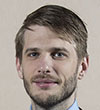Meet our new colleague: Anders Boyd

Could you tell us a little about yourself?
My background is originally epidemiology, but when I went to France for my PhD research at the university of Pierre and Marie Curie in Paris, there was a far stronger focus on statistics. During my time there, I followed many different courses on subjects like modelling strategies. My PhD was on statistical modelling of virological and clinical endpoints in multiple viral hepatitis infection, in other words people who are infected with hepatitis B, hepatitis C and/or hepatitis D. After that I did a couple of post-docs. One looked at genetic variability of hepatitis B in two different cohorts: one in Côte d’Ivoire and one in France. I also looked at clinical outcomes in the same two cohorts, so anything from overall mortality to hepatitis B surface antigen seroconversion, as a measure of functional cure. During that time I also served as a statistician and methodologist for various different studies, ranging from mental health to cardiovascular disease, to plain virology and even bacterial infections.
How did you initially become interested in HIV?
My interest in HIV arose from a masters’ class that I took on infectious disease epidemiology. The professor who taught the course focussed heavily on HIV infection because that was his own area of research. During the class I became very interested in HIV, particularly because of the dramatic change that took place in the HIV field, especially between 1996 and 2005, in contrast to other infectious disease fields. One of the topics that drew my attention was HIV and hepatitis. It seemed to be less evolved and not many people were studying it. However, I was lucky enough to have a colleague in Minnesota, where I was doing my studies, who was also working in France on the subject. So I initially did an internship there and eventually ended up continuing to work there, specifically on HIV and hepatitis.
Were you aware at the time that treatment for viral hepatitis was about to change?
The cohort that I was working on was established in 2002, and we were lucky that this was just when tenofovir came on the market as a treatment for HIV. It also appeared to suppress hepatitis B, but we didn’t really know how it worked in the HIV/hepatitis B co-infected population. So when I arrived, my dataset was ready to be analysed and this allowed me to work on long-term outcomes.
What are you going to focus on in your work at SHM?
Obviously I’ll continue with my expertise on viral hepatitis and some of the models I’ve used previously. In terms of modelling, it would be nice to incorporate more issues associated with viral hepatitis. Some of the other things in the pipeline also include looking at the effects of the newer classes of drugs like the integrase inhibitors and at the clinical outcomes associated with the new regimens. And I’ll also be looking at comorbidities together with Ferdinand Wit. So there’s plenty to do.
And you’re also going to be working part-time at the GGD Amsterdam?
Yes, in some ways that’s a challenge, but it’s also great because GGD Amsterdam works on similar topics and complementary projects, like the ACS study and the AGEhIV study. Another aspect that I like about the GGD work is that it focuses more on the preventative side, which is something that oddly enough I’ve not had the opportunity to work on much before.
It sounds like you’ve got a lot to get on with. What are you looking forward to most in your job at SHM?
Well, the data really. There’s just so much. The datasets I worked on previously were designed to answer more specific questions and were far smaller in terms of patient size, although they did have a broad range of parameters. SHM’s database is great because it allows you to ask a far broader range of research questions. However, it does mean you have to make choices along the way and find the research question that will impact the HIV population the most.
I also like the fact that you can piggyback off the dataset and continue in different research angles, something I think AGEhIV and the ACS study have done really well. It’s nice to see that there are possibilities for smaller sub-studies within the main study.
Additionally, in terms of data, if you compare SHM’s dataset with other HIV-positive datasets, the coverage is incredible: 98% of the HIV-positive people in care in the Netherlands. I don’t think you’ll find that anywhere else really. Often one of the limitations we face is how representative the population is, but with 98% coverage this isn’t much of an issue.
And what do you think will be your biggest challenge here?
Well, I have a few projects that I’m still rounding off in France, and it will be hard to say goodbye to those areas of interest. On the other hand, I’m also looking forward to perhaps building new collaborations with my colleagues in Paris, if the opportunity arises.
